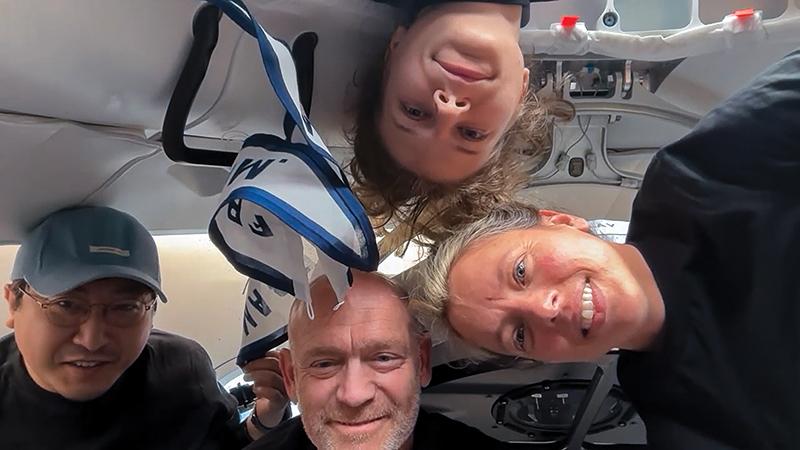This article is published in Aviation Week & Space Technology and is free to read until May 10, 2025. If you want to read more articles from this publication, please click the link to subscribe.

For its sixth privately funded spaceflight, SpaceX sent an international crew of four civilians into polar orbit (counterclockwise from left): Chun Wang, Eric Philips, Jannicke Mikkelsen and Rabea Rogge.
A quartet of civilian polar explorers returned from a 3.5-day spaceflight on SpaceX’s first crewed Dragon splashdown in the Pacific Ocean and a test to see if the first-time flyers could egress the capsule without assistance.
The Dragon splashed down on April 4 at 9:19 a.m. PDT off the coast of Oceanside, California, bringing SpaceX’s sixth private astronaut mission to a close. The company, which is in the midst of its 11th crewed flight to the International Space Station (ISS) for NASA, has flown three private missions for Houston-based Axiom Space to the ISS and three free-flying missions on Dragon spacecraft.
- Dragon is outfitted with cupola for 360-deg. viewing
- SpaceX shifts Dragon splashdowns to the West Coast
The latest mission, known as Fram2, was bankrolled and overseen by Chun Wang, a Chinese-born citizen of Malta who also lives in Svalbard, Norway. He invited three crewmembers to join him for what became the first human spaceflight in polar orbit. They are Norwegian cinematographer Jannicke Mikkelsen, who served as vehicle commander; German roboticist Rabea Rogge, who served as the Dragon pilot; and Australian Eric Philips, a polar explorer and adventure tour guide.
The four met in Svalbard, an archipelago between Norway and the North Pole that is one of the world’s northernmost inhabited areas. “We love the ice,” Chun posted on social media site X during the flight. “The mission was planned when I lived there, and we fly polar because in an ISS-like orbit we are unable to see where we live. From this perspective, the mission has perfectly achieved its goal.”
The mission took its name from the 19th-century Norwegian Fram ship designed for polar research.
Fram2 lifted off on a SpaceX Falcon 9 rocket on March 31 at 9:46 p.m. EDT from the Kennedy Space Center. The rocket headed south along Florida’s coast, overflying Miami, Cuba and Panama on its way to polar orbit.
During the next 3.5 days, the Fram2 crew circled the planet about 55 times, passing over one of the poles every 46.5 min. “Unlike previously anticipated, from 460 km [285 mi.] above, it is only pure white,” Chun wrote on X. “No human activity is visible.”
A Starlink laser link on the Dragon allowed Chun and crewmembers to post on X and conduct video calls while in orbit. SpaceX first tested the system during the September 2024 Polaris Dawn mission, organized, financed and commanded by tech entrepreneur Jared Isaacman.
For Fram2, SpaceX also recycled the Dragon cupola, which had debuted on SpaceX’s first private astronaut mission, Inspiration 4, also chartered by Isaacman. The Fram2 astronauts did not open protective shades on the domed window, which provides a 360-deg. view of Earth and space, until Flight Day 2 due to space motion sickness, Chun noted.
“The first few hours in microgravity weren’t exactly comfortable,” he wrote on X. “Space motion sickness hit all of us—we felt nauseous and ended up vomiting a couple of times. It felt different from motion sickness in a car or at sea. You could still read on your iPad without making it worse. But even a small sip of water could upset your stomach and trigger vomiting.
“No one [asked] about opening the cupola on the first day—we were all focused on managing the motion sickness. We had a movie night watching our own launch and went to sleep a bit earlier than scheduled. We all slept really well.
“By the second morning, I felt completely refreshed,” Chun continued. “We had breakfast, took a few X-ray images and opened the cupola 3 min. after midnight UTC—right above the South Pole.”
Fram2 included 22 research experiments, most of which flew passively without crew involvement. The crew, however, did test a medical X-ray imager and conducted a brain-mapping EEG experiment.
“While I was in space, I saw paradise, pollution, frozen landscapes, city lights, traffic, auroras, vast deserts, oases, volcanoes, agriculture and war. Fram2 has forever changed me,” Mikkelsen wrote on X after landing. “I live in Svalbard, but my home is planet Earth.”
In addition to becoming the first human spaceflight in polar orbit, Fram2 marked the first time that a crew flew with no licensed pilot or trained astronaut on board.
SpaceX also used the mission to test if the crew could egress the capsule without assistance, data that could be useful as the company prepares to fly astronauts to the lunar surface for NASA as part of the Artemis III mission, slated for 2027.



